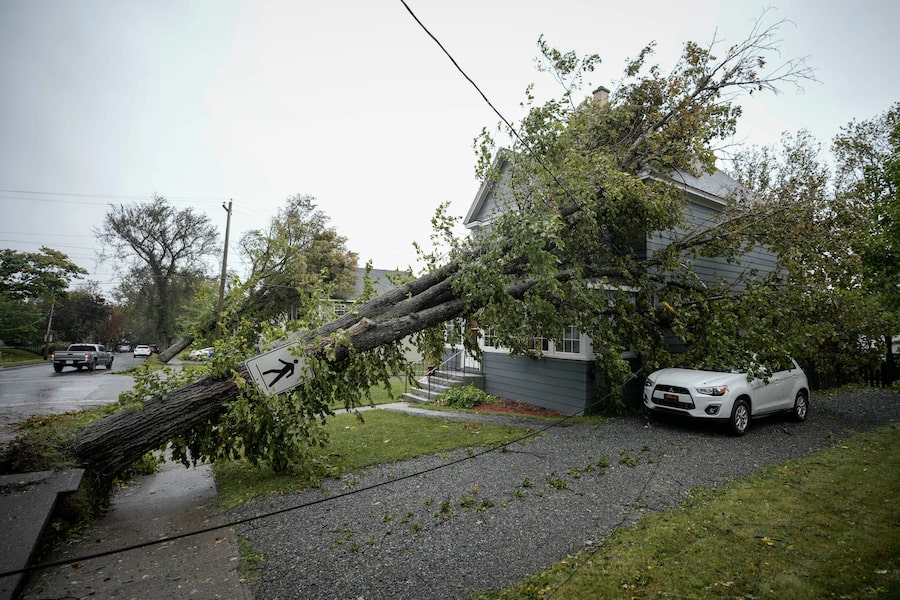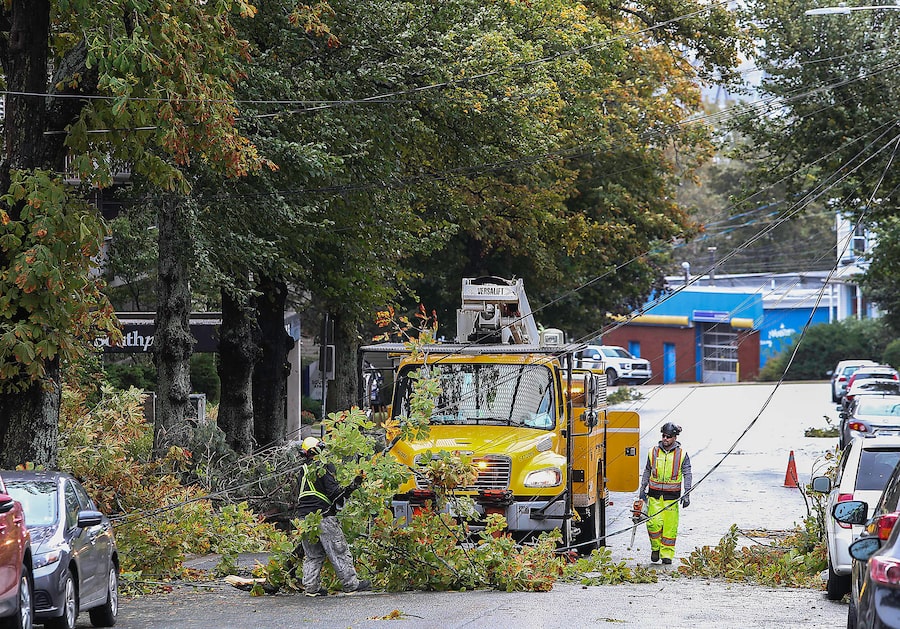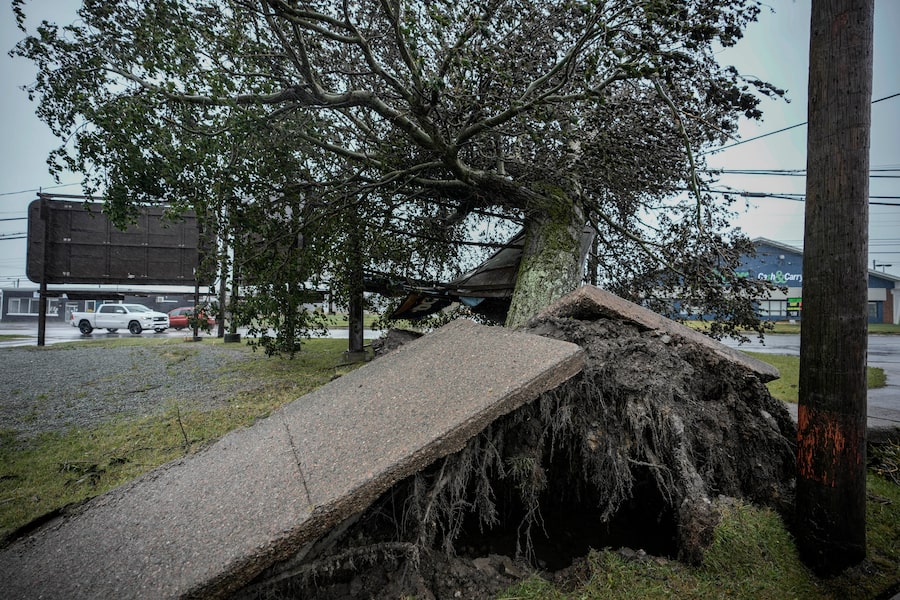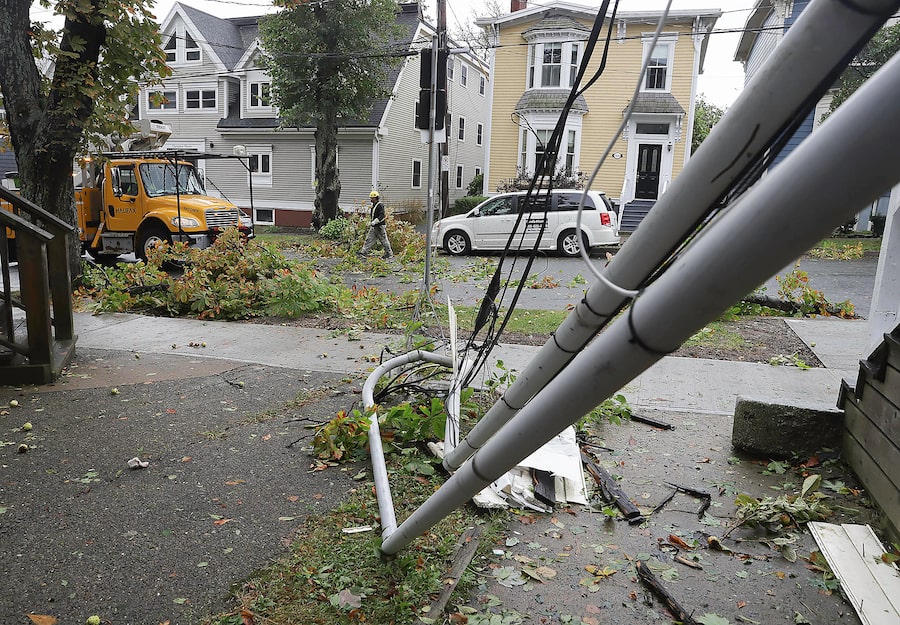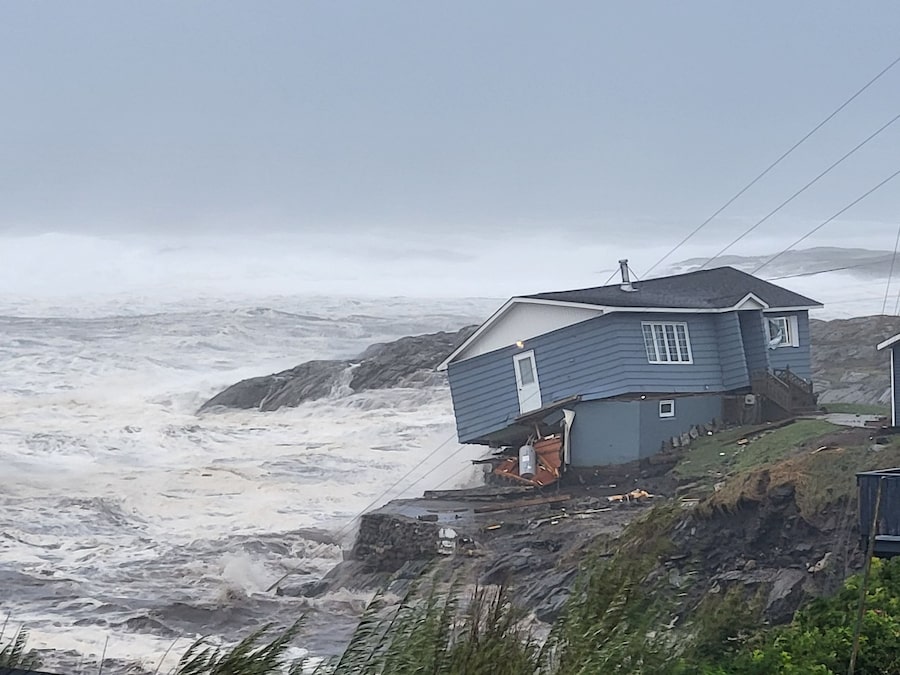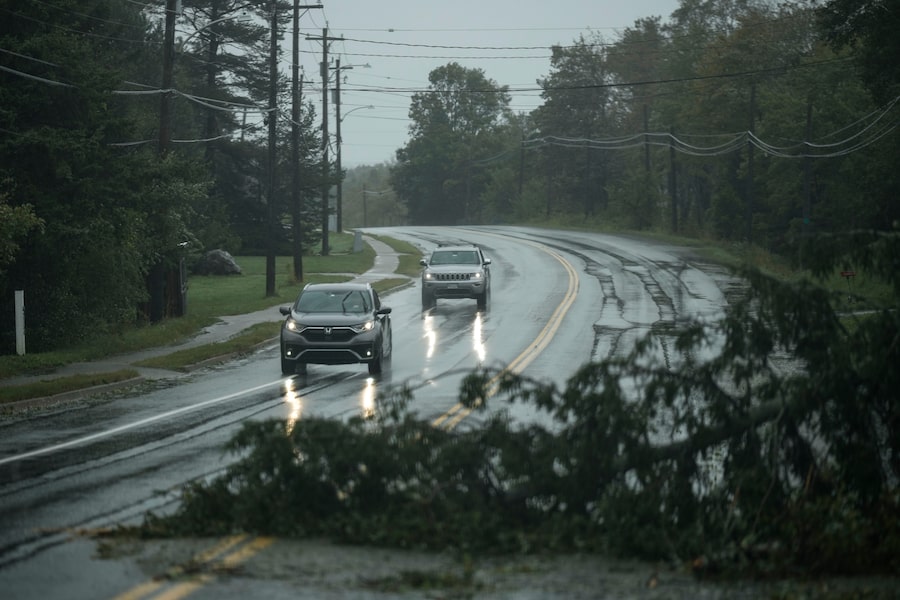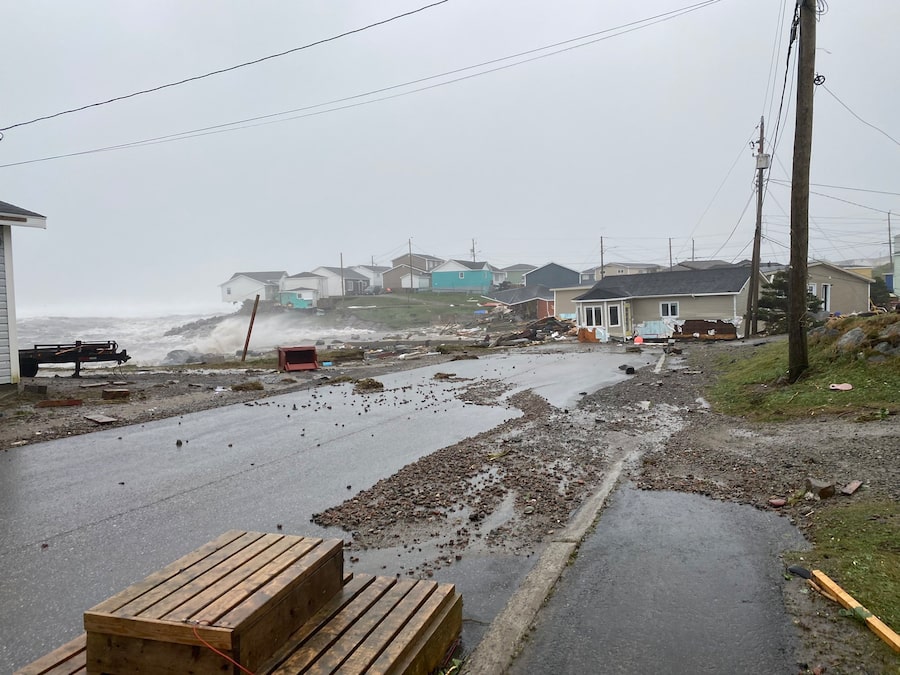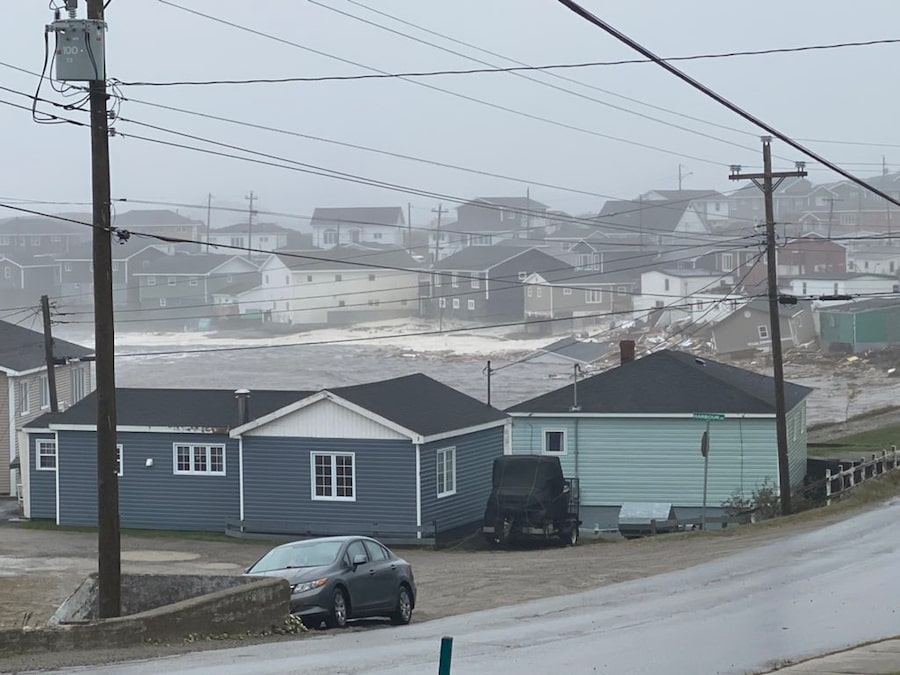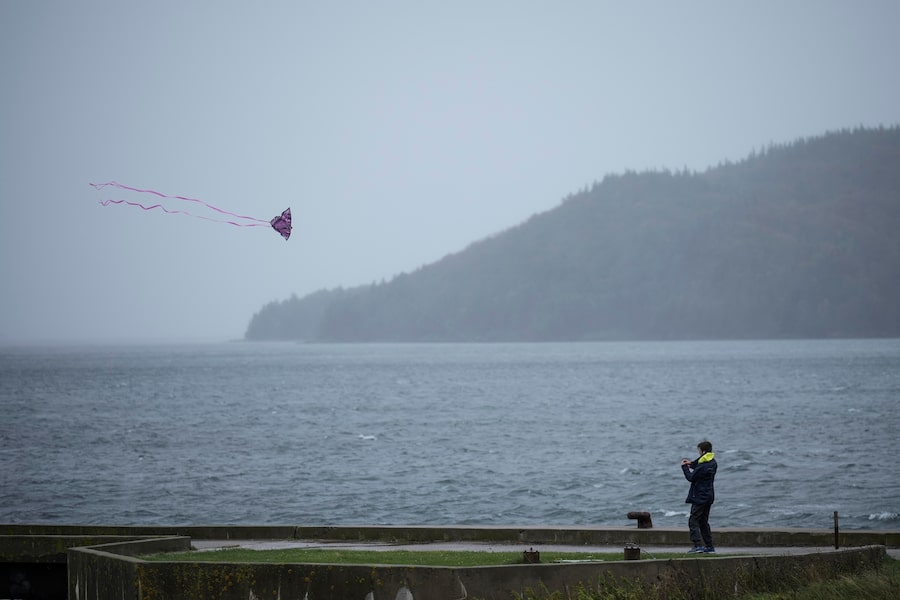Residents stand in flood waters following the passing of post-tropical storm Fiona in Shediac, New Brunswick on Sept. 24, 2022.GREG LOCKE/Reuters
Post-tropical storm Fiona made landfall in Atlantic Canada early Saturday morning, bringing heavy rain, strong winds and storm surge that washed some buildings into the ocean.
Here are the latest updates on Fiona:
- Canadian Armed Forces will be deployed to assist Nova Scotia in its post-tropical storm recovery, Trudeau has announced.
- High winds and storm surge caused much of the destruction in Îles-de-la-Madeleine and Gaspé regions and Quebec City, with breaks on the Hydro-Québec network resulting in power outages and damage to buildings near the coast.
- Massive storm surge and thunderous waves are washing away homes into the ocean in Port aux Basques, N.L.; one woman is reportedly missing after being swept out into ocean in area.
- More than 500,000 customers in Maritimes have been left without power, mostly in Nova Scotia, across Prince Edward Island and Cape Breton; outages may last until the middle of next week for some communities.
- Fiona made landfall at around 4 a.m. Saturday on Canso Peninsula near Hart Island and Guysborough in Nova Scotia.
10:30 p.m. ET
Newfoundland woman recalls being woken by crash of water into her house, flying boulders
Waves roll in near a damaged house built close to the shore as tropical storm Fiona passes the Atlantic settlement of Port aux Basques, Newfoundland and Labrador, Sept. 24, 2022.WRECKHOUSE PRESS/Reuters
Velda Tapp-Pretty was asleep at 8 a.m. Saturday when a wall of water hit her bedroom window with a bang. For several minutes, her home in Channel-Port aux Basques, NL. was flooded with the ocean. She could smell it – seawater surging through the foundation up into her bedroom in her small bungalow.
Boulders flew out of the ocean, into the air and landed in her backyard.
“You could hear the roar and the ripping and I looked out the window and the siding was going just like confetti at a wedding,” she said.
She could see the apartment building across the road was gone. The roof on the house next door to her flapped in the wind. Another house was ripped in half. Boats and ships were in the middle of the street in the town of 4,500 people on the southwestern tip of Newfoundland.
By 8:10 a.m., Ms. Tapp-Pretty, a 57-year-old home-care worker, realized she was in a life-or-death situation. She grabbed her cat, Krissy, leaving behind her other cat, Terri, who was too spooked to come with her – and got in her car. A roof in the middle of the road blocked her way, so she wove through backyards and roads littered with televisions, mattresses and microwaves until she made it safely to her brother’s home.
Read the full story, by Lindsay Jones, here.
8:30 p.m. ET
Severe winds still battering northern Cape Breton Island, western Newfoundland and Îles-de-la-Madeleine, Environment Canada says
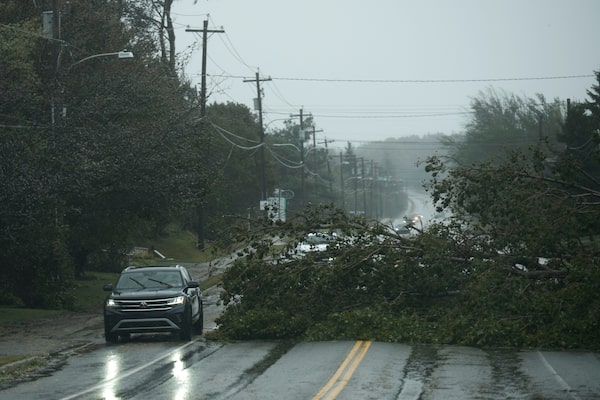
Vehicles navigate around a downed tree from Post-Tropical Storm Fiona on Sept. 24, 2022 in East Bay, Nova Scotia on Cape Breton Island in Canada.Drew Angerer/Getty Images
Environment Canada said severe winds are still battering northern Cape Breton Island, western Newfoundland, and Îles-de-la-Madeleine, in a in a 9 p.m. ADT update. Environment Canada added that eastern Nova Scotia, the Gulf of St. Lawrence and western Newfoundland are experiencing storm surges.
Hurricane Fiona, packing maximum sustained winds of 110 kilometres per hour, is expected to track toward the Quebec lower north shore and southeastern Labrador by late overnight.
“There continues to be rough and pounding surf, especially for parts of Nova Scotia, the southern Gulf of St. Lawrence and Newfoundland. Large waves have reached the eastern shore of Nova Scotia and southwestern Newfoundland, and caused severe coastal flooding to Port-aux-Basques,” the Environment Canada update states.
“The western Gulf saw waves from the north up to 8 metres in places, which probably caused significant erosion for north facing beaches of Prince Edward Island. Îles-de-la-Madeleine also had coastal flooding.”
– Justine Hunter
7:15 p.m. ET
More houses damaged, swept away as Fiona knocks out power in eastern Canada
A fallen tree lies on a house following the passing of Hurricane Fiona, later downgraded to a post-tropical storm, in Halifax, Nova Scotia, Sept. 24, 2022.TED PRITCHARD/Reuters
Fiona washed houses into the sea, tore the roofs off others and knocked out power to the vast majority of two Canadian provinces as it made landfall before dawn Saturday as a big, powerful post-tropical cyclone.
Fiona transformed from a hurricane into a post-tropical storm late Friday, but it still had hurricane-strength winds and brought drenching rains and huge waves. There was no confirmation of fatalities or injuries.
Ocean waves pounded the town of Channel-Port Aux Basques on the southern coast of Newfoundland, where entire structures were washed into the sea. Mayor Brian Button said Saturday over social media that people were being evacuated to high ground as winds knocked down power lines.
– The Canadian Press
6:45 p.m. ET
Trudeau convenes Hurricane Fiona Incident Response Group
Prime Minister Justin Trudeau convened the Incident Response Group to discuss the ongoing impact of Hurricane Fiona on the Atlantic provinces and in Quebec on Saturday, according to a readout from the Prime Ministers’ Office.
He was briefed on what’s being done to supported those affected by the storm through provincial emergency management organizations, as well as telecom and power utility companies, it read.
It also read that Mr. Trudeau, along with other ministers, had “reviewed and confirmed the readiness of key federal resources that may be deployed to provide support to affected areas in the coming days, including the Canadian Armed Forces, the Canadian Coast Guard, Transport Canada, and others.”
– Emerald Bensadoun
5:47 p.m. ET
Flooding and infrastructure damage hit Îles-de-la-Madeleine, Que.

Youth hostel Paradis Bleu is surrounded by high water caused by post-tropical storm Fiona on the Les Îles-de-la-Madeleine, Que., Sept. 24, 2022.nigel quinn/The Canadian Press
Post-tropical storm Fiona brought flooding, damage and debris to Îles-de-la-Madeleine and Gaspé regions in Quebec Saturday. Îles-de-la-Madeleine was hardest hit and in a state of emergency since Friday.
Premier François Legault told a briefing in Quebec City that so far there have been no deaths or injuries reported due to the dangerous storm.
High winds and storm surge Saturday morning caused much of the destruction, with breaks on the Hydro-Québec network resulting in power outages and damage to buildings near the coast. Îles-de-la-Madeleine will also experience some coastal erosion due to the waves, Environment Canada said.
Local officials asked residents to avoid travel and also limit their use of drinking water due to electricity problems on the island as a precautionary measure.
One of two underwater telecommunications cables linking Îles-de-la-Madeleine to the mainland was also damaged Saturday by the storm, about 14 kilometres from the shore, according to an official at Bell. Service is continuing and the second cable has taken over. Generators have been deployed where there has been a loss of power to ensure telephone and cellular service.
Earlier Saturday, about 7,500 people were without power in Îles-de-la-Madeleine and Gaspé, a number that had dropped to 4,100 later in the day but one that utility officials said was in constant flux.
– The Canadian Press
5:08 p.m. ET
Canadian Armed Forces to be deployed to Nova Scotia to assist in recovery
Prime Minister Trudeau and Public Safety Minister Bill Blair announced the Canadian Armed Forces will be deployed to Nova Scotia to assist in the recovery from the devastation wreaked by post-tropical storm Fiona.
Trudeau said that the province had requested federal assistance and that preparations were already underway before the storm hit on Saturday.
Mr. Trudeau also announced that the federal government will be matching any Red Cross donations Canadians or corporations make towards the relief effort for the next 30 days.
Mr. Blair said there had been “severe damage” to homes, infrastructure and airports, while the Prime Minister said that recovery is going to be a “big effort.”
– Prajakta Dhopade
4:55 p.m. ET
Trudeau and ministers provide an update on federal response to storm
4:33 p.m. ET
Quebec campaign trail disrupted by storm Fiona
Post-tropical storm Fiona caused some disarray on the Quebec campaign trail Saturday as some parties cancelled planned events and Coalition Avenir Québec Leader François Legault briefly suspended his campaign to manage the province’s response to the gale.
Mr. Legault resumed his re-election bid in the afternoon after meeting with public security officials in Quebec City and holding a briefing with reporters. However, a major partisan rally on Saturday night in Terrebonne, north of Montreal, was postponed, he said.
In Quebec, Fiona hit the Îles-de-la-Madeleine, Gaspé and the province’s Lower North Shore, with the brunt of the impact expected from Saturday to Sunday morning.
– The Canadian Press
3:42 p.m. ET
Residents take shelter after Fiona damages homes in Sydney, N.S.
2:35 p.m. ET
‘Never seen anything as intense as this’: Port aux Basques resident recounts storm horror
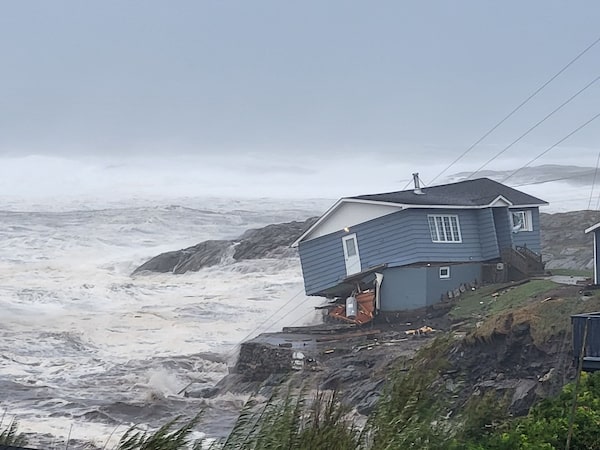
Post-tropical storm Fiona strikes Port aux Basque, Newfoundland on Sept. 24, 2022.Wreckhouse Press/Handout
Alvin Sheaves, 68, said he was woken up at 6 a.m. Saturday in Port aux Basques by howling winds that shook his house. As a lifelong resident of the seaside community, he said people they are used to big storms, but Fiona’s fury was unprecedented.
“I’ve never seen anything as intense as this,” he said. “When you live in a seaport town, there’s a lot of things you expect. But I haven’t experienced anything like this before.”
Mr. Sheaves said he was horrified to watch his neighbours’ homes be destroyed as they were pulled into the sea. The wind was so loud it was impossible to sleep once it slammed into the community of about 4,000, he said.
“I’m just hoping and praying for all those people,” he said.
– Greg Mercer, Saint John
2:03 p.m. ET
One woman missing after being swept out into ocean in Port aux Basques
RCMP say two women have been swept out into the ocean in separate incidents as post-tropical storm Fiona hammered the town of Port aux Basques on the southwestern tip of Newfoundland.
One of the women was rescued by bystanders and is expected to make a full recovery, while the other woman is still missing. RCMP spokesperson Jolene Garland said police are investigating the incident.
Ms. Garland said the devastation from the storm in the province has so far been centered in Port aux Basques, a town of roughly 4,000 people where the Trans Canada Highway ferry lands on Newfoundland.
Rene Roy, editor-in-chief for local media outlet and publisher Wreckhouse Press Inc., said he had seen at least nine homes that were swept into the ocean, including a two-storey apartment building.
”The harbours are filled with debris and remnants of homes, this is simply incredible,” said Mr. Roy, who said people are worried about the island being cut off from the mainland.
– Salmaan Farooqui
11:23 a.m. ET
Power outages may last until middle of week for some communities
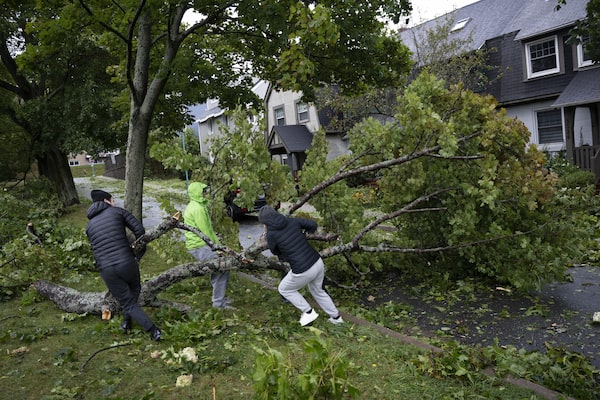
People work to drag a fallen tree limb from their street as post tropical storm Fiona causes widespread damage in Halifax on Sept. 24, 2022.Darren Calabrese/The Canadian Press
In Halifax, the streets were littered with uprooted trees, power poles snapped in pieces and draping power lines. The loud hum of generators filled the air as homeowners prepared for days without electricity.
At 11:30 p.m. on Friday night, Andrew Inch heard a thump and was shocked to see a 50-foot maple tree had fallen against the front of his two-storey north end Halifax home.
“It was hard to sleep last night knowing a tree is resting against the side of the house. It is being suspended in part by a Nova Scotia Power wire, or maybe a few branches,” said Mr. Inch, who has two young children.
“The kids woke up this morning and were very excited that they had a treehouse in their front yard.”
Nova Scotia Power is predicting lengthy outages from Fiona. There are still 400,000 customers without power across the province. Crews from New Brunswick, Maine and Quebec are joining local crews to help with the storm restoration, which may take up until the middle of next week for some communities.
Power crews are preparing to go up in buckets to start restoring power when the winds decrease below 80 kilometres an hour.
– Lindsay Jones, Halifax
11:06 a.m. ET
Houses wash away in Port aux Basques, N.L.; one person reported missing
An evacuation order was made in several communities along Newfoundland’s southwestern coast, where a massive storm surge and thunderous waves were washing homes in the ocean. In Port aux Basques, a two-storey apartment building was pulled into the sea, along with multiple buildings. One person was reported missing as emergency officials went door to door, urging people to leave.
Images and video from the community show houses sliding into the water, getting smashed on the rocks and floating out to sea. In Burnt Islands, a causeway that connects the community was swallowed by the rising ocean waters, as sheds, homes and other buildings disappeared into the waves.
“Connection to the island portion of the community of Burnt Islands now cut off. I’m told some folks are stuck on the other side, but at a higher location,” tweeted Michael King, a special adviser to the province’s Premier, Andrew Furey.
– Greg Mercer, Saint John
10:29 a.m. ET
Explainer: How climate change is affecting the intensity of hurricanes
Climate change is making hurricanes wetter, windier and altogether more intense. There is also evidence that it is causing storms to travel more slowly, meaning they can dump more water in one place.
If it weren’t for the oceans, the planet would be much hotter due to climate change. But in the last 40 years, the ocean has absorbed about 90 per cent of the warming caused by heat-trapping greenhouse-gas emissions. Much of this ocean heat is contained near the water’s surface. This additional heat can fuel a storm’s intensity and power stronger winds.
Climate change can also boost the amount of rainfall delivered by a storm. Because a warmer atmosphere can also hold more moisture, water vapour builds up until clouds break, sending down heavy rain.
– Reuters
9:27 a.m. ET
Trudeau delays trip to Japan; federal government in touch with local MPs to provide assistance
Prime Minister Justin Trudeau has delayed his Saturday departure for Japan, where he was to attend the funeral of Shinzo Abe, the country’s former prime minister. The federal government has pledged support of the affected provinces, according to tweets from Mr. Trudeau’s press secretary, Cecely Roy, posted last night.
9:15 a.m. ET
Post-tropical storm Fiona’s forecasted path

Murat Yukselir/The Globe and Mail
8:36 a.m. ET
Power repair, emergency services delayed by high winds, flooding
The number of people without power is expected to climb as the day goes on. In many areas, high winds are making it too dangerous for hydro crews to begin repair work. The drone of generators can be heard in many neighbourhoods as people wake up to dark streets.
Multiple communities, particularly on P.E.I., eastern Nova Scotia and Cape Breton, have declared local states of emergencies, asking residents not to leave their homes. Police in Charlottetown, where trees were uprooted and split in half, say the conditions are the worst they’ve ever seen. RCMP on P.E.I. are telling residents to stay away from windows out of concern over flying debris.
In eastern New Brunswick, a storm surge caused by large waves have flooded multiple roads in coastal areas and have forced some people from their homes. Emergency officials are warning people to be patient in their requests for help, with significant tree damage blocking roadways and slowing their ability to reach certain areas.
– Greg Mercer, Saint John
8:18 a.m. ET
Cape Breton declares state of emergency
The Cape Breton Regional Municipality has declared a state of emergency, as post-tropical storm Fiona – one of the strongest storms to ever strike Canada’s East Coast – continues to lash the island.
In Sydney, the largest city in Cape Breton, the wind caused severe damage to some homes, forcing families to flee.
“We’ve had several structural failures,” said Christina Lamey, a spokesperson for the region. She confirmed that no one was hurt. She said it was unclear how many homes had been damaged, but there were reports of collapsed walls and missing roofs.
“The key message from that is for people to stay at home,” Ms. Lamey said in an interview. “The first responders are really stretched right now. We want people to stay off the roads. Most of the roads have hazards on them, with power lines down and trees down as well.”
– The Canadian Press
8:13 a.m. ET
Photos capture the damage so far as Fiona pummels Maritimes
7:50 a.m. ET
Fiona makes landfall in Nova Scotia; hundreds of thousands without power in Maritimes
Ian Livingstone surveys the damage to his house from a fallen tree early in the morning in Halifax on Saturday, September 24, 2022 as post tropical storm Fiona continues to batter the Maritimes. THE CANADIAN PRESS/Darren CalabreseDarren Calabrese/The Canadian Press
Post-tropical storm Fiona made landfall early Saturday in Nova Scotia and is the lowest pressured land falling storm on record in Canada, according to the Canadian Hurricane Centre.
The storm has knocked out power to more than 500,000 customers in the Maritimes, with most of the damage reported in eastern Nova Scotia, across P.E.I. and Cape Breton. As of 7 a.m. local time, Maritime Electric was reporting outages affecting 82,138 customers, out of the 86,000 served by the utility company. Nova Scotia Power reported 412,041 customers were in the dark, and NB Power reported 44,329 were without electricity.
The centre said widespread gusts between 90 and 120 kilometres per hour have been reported over Nova Scotia, P.E.I., Iles-de-la-Madeleine, Que., and southwestern Newfoundland, with a peak gusts to 161 kilometres per hour over Beaver Island, N.S.
Parts of eastern mainland Nova Scotia and P.E.I. have recorded 75 to 125 millimetres of rainfall.
The “historic” storm was forecasted to bring between 100 to 200 millimetres of rain across much of Atlantic Canada and eastern Quebec, with more than 200 millimetres expected to fall in areas closer to the storm’s path.
– The Canadian Press
